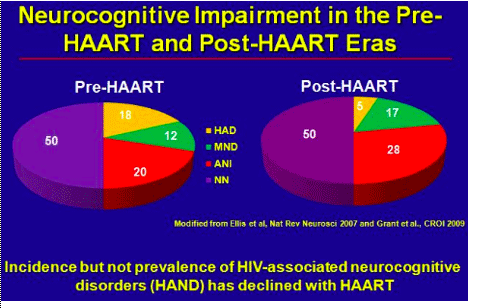 |
 |
 |
| |
ART Improves Cerebral Blood Flow--But Not to Levels in HIV-Negatives
|
| |
| |
17th Conference on Retroviruses and Opportunistic Infections, February 16-19, 2010, San Francisco
Mark Mascolini
From Jules: see slides below. Ances summarizes: HIV significantly reduces cerebral blood flow prior to changes in neurologic funtion. HAART improves but does not normalize blood flow. The new test he discusses is easy to use and can characterize blood flow in patients.
Antiretroviral therapy significantly increased resting cerebral blood flow (rCBF) in HIV-infected people starting antiretroviral therapy, according to results of small cross-sectional and longitudinal studies, but blood flow does NOT return to normal [1]. The results rest on a noninvasive neuroimaging technique--arterial spin labeling magnetic resonance imaging--that Beau Ances and colleagues at Washington University (St. Louis) believe could be a reliable preclinical marker of HIV's effects in the brain [2]. Using this technique in an earlier study, Ances found that "functional brain demands in HIV-positive subjects were equivalent to those of HIV-negative subjects who were 15-20 years older" [3].
Incidence, but not prevalence, of HIV-associated neurocognitive disorders has dropped since the advent of triple therapy. To determine the effects of current antiretroviral regimens on neurocognitive function as assessed by rCBF, Ances mounted two studies--a cross-sectional comparison of 26 people without HIV and 39 with HIV, and a longitudinal study of 11 people starting their first antiretrovirals and followed for 3 to 5 months. The cross-sectional comparison involved 13 people taking a stable antiretroviral regimen for more than 3 months and 26 still naive to antiretroviral therapy. Eleven of these 26 entered the longitudinal study.
In the cross-sectional study, the HIV-negative, naive, and treated groups did not differ significantly in age (averaging 34, 33, and 38 years) or education (14, 13, and 15 years). The antiretroviral-experienced group included a higher proportion of men (93%) than the naive group (88%) or HIV-negative group (73%), but these differences were not significant (P = 0.09). Median CD4 count stood at 485 in the treated group and 357 in the untreated group (P = 0.16), nadir CD4 count at 127 and 320 (P = 0.002), and viral load at 2.08 and 3.95 log (P = 0.0005). Neuropsychological performance on five tests did not differ significantly between the three study groups.
Global rCBF was significantly higher in HIV-negative controls (about 64 mL/100 g/min) than in the naive or treated groups with HIV (P < 0.05). Treated people with HIV had significantly higher rCBF than untreated people (about 55 versus 46 mL/100 g/min, P < 0.01), but it did not return to normal. The longitudinal analysis recorded significant declines in plasma viral load in each of the 9 people studied, and significant jumps in rCBF in 8 of these 9 people.
Ances postulated that HIV causes synaptodendritic injury that leads to reduced rCBF. Antiretroviral therapy improves but does not normalize rCBF. He suggested that "effective treatment of HIV central nervous system disease might require earlier administration of both HAART and 'adjunctive' therapies designed to ameliorate synaptodendritic injury."
The missing link in this line of research is correlation between rCBF and later clinical outcomes.
References
1. Thomas J, Peng H, Benzinger T, Mintun M, Clifford D, Ances B. HIV treatment modulates global resting cerebral blood flow in HIV+ subjects. 17th Conference on Retroviruses and Opportunistic Infections. February 16-19, 2010. San Francisco. Abstract 171.
2. Ances BM, Sisti D, Vaida F, et al. Resting cerebral blood flow: a potential biomarker of the effects of HIV in the brain. Neurology. 2009;73:702-708.
3. Ances BM, Vaida F, Yeh MJ, et al. HIV infection and aging independently affect brain function as measured by functional magnetic resonance imaging. J Infect Dis. 2010;201:336-340.



Ances: there is an increase since advent of HAART in milder forms of dementia, there is a shift from more impairment to less impairment. Although incidence is decreased since HAART prevalence is increased because either patients are living longer and/or not as effective therapy into CNS.


Ances said: in panels on the right you see a progressive step-wise decrease in blood flow with increasing degree of neurocognitive impairment. In particular patients with HAD had significantly reduced blood flow compared to that of sero-negative controls.

Ances: this data suggests there are different areas affected by HIV, initially subcorticol areas and with time corticol areas become involved.

As a result of the effect of aging by HIV a 55 year old HIV+ individual is equal to a 65 year old HIV-neg person. “HIV equals to about 15 years of aging in the brain.”




Naives (even though their Cd4 count was average 350) had a lower blood flow than HIV-neg controls. Medicated patients had an increase in blood flow but it did not return to baseline





|
| |
|
 |
 |
|
|